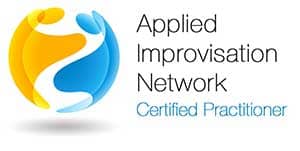Consider how many times you hear the phrase “no, but” in a day. Now consider how many times a student hears shutting down phrases like “no, but” in their average school day during interactions with classmates and teachers. Consider how that must make them feel. What’s more is that when students are met with “no, but” from others, it becomes easier for them to adopt the phrase to shut down others themselves. Students today seem to be often living in this world of “no, but” when they need and deserve a flourishing environment that promotes their learning process and discussion of ideas rather than staggers it. This is especially the case for students considered disadvantaged due to a learning disability and/or economic, social, and familial circumstances.
Applied improvisation has the power to bring these students into a supportive environment where their thoughts are heard and accepted. The magic lies in the improv mantra “yes, and,” where improvisers accept all offers as true and build off them to achieve an outcome. Here we will describe just how applied improvisation can create a world of possibilities for disadvantaged students by promoting academic improvement among other powerful benefits.
The school environment can be a tricky social context to navigate for all students in that they may not always feel they fit in. Since 2003, students’ sense of belonging has been decreasing in the school environment, and this is especially the case for disadvantaged students, who are about 8 percent less likely to report that they feel like they belong. Studies have found a correlation between a students’ sense of belonging and academic achievement, such that students who report feeling unaccepted score lower in subjects like science.1
Often times these feelings of not belonging manifest themselves in the students’ behavior through social anxiety and or being shy/non-participatory in and outside of the classroom. The “yes, and” foundation of applied improvisation can offer emotional and psychological benefits for these students while helping them make the school environment a more positive place. The problem is that applied improvisation doesn’t seem like the obvious method to ease social anxiety and shyness given the performance and risk taking elements of it.
That is merely a misconception. In reality, practicing “yes, and” in a low risk environment through applied improv fosters confidence, self-esteem, collaboration, communication, and creative problem solving skills. Students through applying improv can overcome their fears and excel in academics! In applied improvisation, students feel a sense of belonging because acceptance is required by everyone in the room through “yes, and.” Therefore, students feel that their ideas are listened to and validated in this environment. This alone has several learning benefits:
-First, students develop confidence and self-esteem that’ll transfer over into their lives by participating and practicing the “yes, and” mindset in a supportive applied improvisation space. This helps students diminish their fear of judgment in that students are taught to support one another and to keep flowing.
-Second, “yes, and” requires students to really listen, communicate, and collaborate with one another to achieve an ultimate goal. By practicing sharing and building off of ideas in applied improvisation, students are able to be master communicators, collaborators, and problem-solvers outside of applied improv while reducing their social anxiety due to practicing being comfortable in the uncomfortable.
-Third, because “yes, and” creates a positive atmosphere in the applied improv classroom, students understand what is needed in a positive thriving environment and they know how to help create it through active engagement, positivity, and empathy.
-Fourth, the “yes, and” mindset helps students overcome fear of uncertainty in that they gain confidence in managing it through saying “yes, and” to circumstances they may not be used to/comfortable with in gameplay. This makes them ready and resilient towards any curveballs life may throw at them.
-Fifth, active engagement of both the mind and body is required as it’s not enough to just say “yes, and” but to express it using the entire body. This increases mental and physical health and improves communication among students.
School, perhaps all of the sudden, is place for opportunities because “yes, and” has joyfully introduced the impossible as possible. School staffs are climbing aboard the “yes, and” ship as they watch their students who participate in applied improv excel in their attendance, classroom participation, overall grades, and interactions with one another. A middle school in Detroit reported that their “student improvisers have had two-fold growth in their overall academic achievement.” 2 Applied improvisation is actually instilling new skills within these students due to its spontaneous emotional and physical elements. Neurologist Judy Willis explains this: “Because the dramatic event (in applied improv) powers its way through the neural pathways of the emotionally pre-activated limbic (emotional brain) system into memory storage, the associated hitch-hiking academic information gets pulled along with it.”
Therefore, applied improvisation, the method that seems least likely to aid social anxiety and help one fit in, actually proves to be the best method while enhancing overall academic performance. Now more than ever, considering the No Child Left Behind Act, it is important to bridge the gap between advantaged and disadvantaged students and ensure that it is possible for all students to succeed academically and feel like they belong.3 Getting comfortable with the uncomfortable is a skill every student needs to overcome obstacles and turn them into triumphs. So let’s get started shall we?
Looking to improve communication, collaboration, and creativity within your teams?
Work with Christiana – International.
Quarterly Free meetups
Facebook pages
References:
1 https://www.oecd-ilibrary.org/docserver/9789264273856-11-en.pdf?expires=1561153799&id=id&accname=guest&checksum=5A0A50929C1D82333E9E299ABD76301C
2 https://www.aate.com/benefits-of-theatre-ed
3 https://medium.com/@judetrederwolff/how-the-improv-project-helps-detroit-students-discover-whats-possible-98acedccea67











